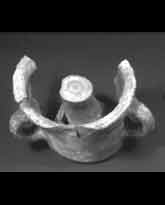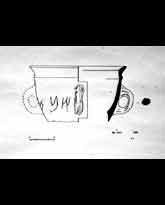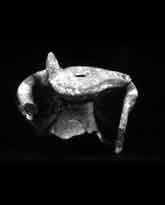A Sabbath Lampstand from Kh. Uza
Hana Eshel and Dina Avshalom-Gorni

The Object
Salvage excavations conducted in 1963 by A. Ben Tor and in 1991 by N. Getzov at Kh. Uza, at the eastern edge of there plain of Acco, revealed, among other things, remains of potters work-shops dated to the Byzantine period (Getzov's Strata 9-7, fourth-fifth centuries CE). Large quantities of vessels and wasters found in Stratum 8 indicate that pottery production played an important role in the livelihood of the inhabitants in the latter part of the fourth century CF

A Fragment With a Three-Letter
Among the vessels formed at the site was an unusual object with no known parallels. It is a cup-like vessel with three vertical loop-handles, the interior of which is occupied by a flat-topped inverted cone. The vessel may be identified as a suspendable stand, upon which a lamp could be placed, its mouth slightly overlapping the external rim. A fragment of one such stand bears a three-letter Inscription, which we read as שבת (Sabbath).

The limited capacity of lamp reservoirs was a source of constant concern for observers of ritual law, as it was forbidden to move or add oil to lamps on the Sabbath. The Mishnah discusses means of enabling the lamp to burn longer (Shabbat 2:4), proscribing those methods which appear to involve handling of the lamp or reservoir and permitting those in which the lamp is provided with an intrinsic “extra" reservoir. The lamp stand from Kh. Uza appears to provide the means for enlarging the oil reservoir of a larrip on the Sabbath, within the parameters of ritual law.
With the stand filled with oil, the wick of the lamp on the stand could be drawn through the eye of the lamp (or through a hole in its base and coiled around the internal cone, drawing oil from the enlarged reservoir. Thus, the Uza lamp stands may have been designed with the specific ritual needs of Jews or of Samaritans in mind.
Additional Articles ...